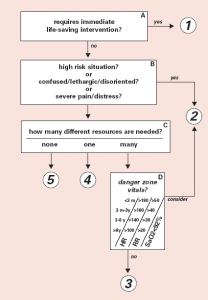By Cameron on February 15th, 2014 in
Show Notes with
Blood gas normal values (check with your own facility):
pH – 7.35-7.45
CO2 – 35-45
HCO3 – 22-26
ROME – Respiratory Opposite, Metabolic Equal
Think of CO2 as acid: High CO2 = acidic
Respiratory – fast compensation
Metabolic – slow compensation
Anion Gap: traditional (Na + K) – (Cl + HCO3), modern equation Na – (Cl + HCO3)
By Cameron on February 15th, 2014 in
Podcasts with
This episode covers interpreting a blood gas, as well as goes more in depth on acid base (though not too in depth) and then applies the discussed topics to a patient in DKA, one of the most common metabolic disorders you will see in the ED. www.edcrashcart.com
Podcast: Play in new window | Download
By Cameron on February 11th, 2014 in
Show Notes with
So you don’t have to track through all the mnemonics listed in the show, here they are in a quick summary, as well as the link to the Blakemore Tube Insertion
Pain mnemonic: OPQRST
O – Onset (when did this start, what were you doing at the time?)
P – Provoking and Palliative (what makes this pain better or worse?)
Q – Quality (what does it feel like? Remember, pressure and tightness are pain!)
R – Region and Radiation (point to where it hurts, where does the pain go from there?)
S – Severity (0-10 scale)
T – Time (how long does the pain last, have you had it before, how does it feel compared to times in the past?)
Chest Pain BIG BAD UGLIES mnemonic: PET MAC
P – PE
E – Esophageal Rupture
T – Tension Pneumothorax
M – MI
A – Aortic Dissection
C – Cardiac Tamponade
Chest Pain focused physical assessment: AABBCC
A – Appearance (do they *look* sick? responsive? labored breathing?)
A – Auscultations (remember to palpate the chest while you’re auscultating heart sounds to check for pain you can reproduce)
B – Back
B – Belly (any auscultated or palpated pulses? tender to palpation pain?)
C – Circulation (radial, cap refill, turgor, JVD, edema [unilateral vs. bilateral, pitting vs. non-pitting], dorsalis pedis, cap refill in toes)
C – Color (pale? jaundiced? pink, warm, and dry? lower extremity discoloration?)
Episode 03 – Chest Pain
This episode discusses focused assessment, differential diagnosis, interventions, and evaluations for the heavy hitters of chest pain. Filled with more mnemonics than you can shake a stick at, this episode is the first of the chief complaint series, talking about how to approach the most common complaints seen in the ED. www.edcrashcart.com
Podcast: Play in new window | Download
By Cameron on February 7th, 2014 in
Support with
After early struggles to get the ball rolling, the podcast is now searchable on iTunes, which means I can focus on cranking out content. I want to get two podcasts out next week, focusing on tackling the big-ol’ chest pain chief complaint and then something supplemental, likely on acid-base, as that will be important for future concepts. Due to the way iTunes handles the podcast feed, each episode from now on will likely contain two posts – one with the podcast and podcast description (which iTunes will use), and a second, acting as the show notes, with any images, videos, or links talked about in the show.
By Cameron on February 5th, 2014 in
Podcasts with
In this episode, I talk about what makes the ED different than other critical care and floor nursing environments, and talk about what roles and areas you can expect to see in an Emergency Department.
After a few weeks of attempting to get my podcast feed submitted to iTunes, I changed wordpress plugins to PowerPress, deleted my old posts, reposted the poscasts, and iTunes accepted the feed. So, in a week or so, the podcast should be searchable on iTunes, and I’ll be sure and link the feed here, too. Special thanks to Pretty Lights for the background music of today’s episode.
As mentioned in the show, here’s the ESI algorithm:

Podcast: Play in new window | Download
By Cameron on February 5th, 2014 in
Podcasts with
Hello and welcome to the podcast! This is the first episode, where I discuss what this podcast will be covering, and some tips for your first days in the Emergency Department. Subscribe to the podcast to stay up to date with this project and receive all future episodes. Thanks, and safe nursing!
Podcast: Play in new window | Download

